Infrared Spectroscopic Determination of Strongly Bound Cyanides in Water
Abstract
1. Introduction
2. Experimental
2.1. Materials and Reagents
2.2. Preparation of Cyanide Solutions
2.3. Calibration of Cyanide Solutions Using ATR
2.4. Addition of CTAB
2.5. Environmental Samples
2.6. Recording IR Spectra of Membranes Containing Cyanide Particles
3. Results and Discussion
3.1. Qualitative Aspects of the Method
3.1.1. Precipitation of SADs-CN Using CTAB
3.1.2. Speciation of Precipitated SADs-CN
3.1.3. Particle Diameter
3.2. Quantitative Aspects of the Method
3.2.1. Quantification of [Fe(CN)6]3−, [Co(CN)6]3−, and [Au(CN)2]− on a Membrane
3.2.2. Mixture Containing [Au(CN)2]−, [Fe(CN)6]3−, and [Co(CN)6]3−
3.3. Environmental Samples of Unknown Concentrations
4. Conclusions
Supplementary Materials
Author Contributions
Funding
Institutional Review Board Statement
Informed Consent Statement
Data Availability Statement
Conflicts of Interest
References
- Flynn, C.M.; Haslem, S.M. Cyanide Chemistry: Precious Metals Processing and Waste Treatment; US Department of the Interior, Bureau of Mines: Washington, DC, USA, 1995.
- Long, L.; Yuan, X.; Cao, S.; Han, Y.; Liu, W.; Chen, Q.; Han, Z.; Wang, K. Determination of cyanide in water and food samples using an efficient naphthalene-based ratiometric fluorescent probe. ACS Omega 2019, 4, 10784–10790. [Google Scholar] [CrossRef] [PubMed]
- Brisbin, J. Cyanide Clarification of Free and Total Cyanide Analysis for Safe Drinking Water Act (SDWA) Compliance, Revision 1.0; U.S. Environmental Protection Agency: Washington, DC, USA, 2020.
- U.S. Environmental Protection Agency (EPA). Ambient Water Quality Criteria for Cyanide-1984; U.S. Environmental Protection Agency: Washington, DC, USA, 1984.
- Halim, M.A.; Naidu, R. Chapter 15-Cyanide contamination of soil and water: Sources, toxicity, and potential remediation strategies. In Inorganic Contaminants and Radionuclides; Naidu, R., Ed.; Elsevier: Amsterdam, The Netherlands, 2024; pp. 375–403. [Google Scholar] [CrossRef]
- Safizadeh, F.; Ghasemian-Langeroudi, E.; Gagnon, C.; Larachi, F. Detection and identification of cobalt cyanide complexes using capillary electrophoresis. Sep. Sci. Technol. 2014, 49, 691–701. [Google Scholar] [CrossRef]
- Donato, D.; Nichols, O.; Possingham, H.; Moore, M.; Ricci, P.; Noller, B. A critical review of the effects of gold cyanide-bearing tailings solutions on wildlife. Environ. Int. 2007, 33, 974–984. [Google Scholar] [CrossRef] [PubMed]
- Mudder, T.I.; Botz, M.M.; Smith, A.P.L. Chemistry and Treatment of Cyanidation Wastes, 2nd ed.; Mining Journal Books: London, UK, 2001. [Google Scholar]
- Hu, M.; Wang, A.P.; Luo, J.; Wei, Q.; Liu, T.L. Cycling performance and mechanistic insights of ferricyanide electrolytes in alkaline redox flow batteries. Adv. Energy Mater. 2023, 13, 2203762. [Google Scholar] [CrossRef]
- Fell, E.M.; De Porcellinis, D.; Jing, Y.; Gutierrez-Venegas, V.; George, T.Y.; Gordon, R.G.; Granados-Focil, S.; Aziz, M.J. Long-term stability of ferri-/ferrocyanide as an electroactive component for redox flow battery applications: On the origin of apparent capacity fade. J. Electrochem. Soc. 2023, 170, 070525. [Google Scholar] [CrossRef]
- ASTM D7237-18; Standard Test Method for Free Cyanide and Aquatic Free Cyanide with Flow Injection Analysis (FIA) Utilizing Gas Diffusion Separation and Amperometric Detection. ASTM: West Conshohocken, PA, USA, 2019.
- ASTM D4282-15; Standard Test Method for Determination of Free Cyanide in Water and Wastewater by Microdiffusion. ASTM: West Conshohocken, PA, USA, 2022.
- ASTM D6888-16; Standard Test Method for Available Cyanides with Ligand Displacement and Flow Injection Analysis (FIA) Utilizing Gas Diffusion Separation and Amperometric Detection. ASTM: West Conshohocken, PA, USA, 2023.
- ASTM D7284-20; Standard Test Method for Total Cyanide in Water by Micro Distillation Followed by Flow Injection Analysis with Gas Diffusion Separation and Amperometric Detection. ASTM: West Conshohocken, PA, USA, 2013.
- ASTM D7511-12; Standard Test Method for Total Cyanide by Segmented Flow Injection Analysis, In-Line Ultraviolet Digestion and Amperometric Detection. ASTM: West Conshohocken, PA, USA, 2017.
- U.S. Environmental Protection Agency (EPA). Method 335.4 Determination of Total Cyanide by Semi-Automated Colorimetry; U.S. Environmental Protection Agency: Washington, DC, USA, 1993.
- APHA Method 4500-CL; Standard Methods for the Examination of Water and Wastewater. APHA: Washington, DC, USA, 1992.
- U.S. Environmental Protection Agency (EPA). Method 9016 Free Cyanide in Water, Soils and Solid Wastes by Microdiffusion; U.S. Environmental Protection Agency: Washington, DC, USA, 2010.
- Ibnul, N.K.; Russell, J.; Dennen, K.; Tripp, C.P. Quantification of free and weakly bound cyanide in water using infrared spectroscopy. Talanta 2024, 266, 124939. [Google Scholar] [CrossRef] [PubMed]
- Saleh, S.H.; Tripp, C.P. A reagentless and rapid method to measure water content in oils. Talanta 2021, 225, 121911. [Google Scholar] [CrossRef] [PubMed]
- Asaoka, S.; Kiso, Y.; Nagai, M.; Okamura, H. A membrane extraction method for trace level phosphate analysis. Anal. Methods 2015, 7, 9268–9273. [Google Scholar] [CrossRef]
- Ibnul, N.K.; Tripp, C.P. A solventless method for detecting trace level phosphate and arsenate in water using a transparent membrane and visible spectroscopy. Talanta 2021, 225, 122023. [Google Scholar] [CrossRef] [PubMed]
- U.S. Environmental Protection Agency (EPA). Casual Analysis/Diagnosis Decision Information System (CADDIS). 2024. Available online: https://www.epa.gov/caddis/ionic-strength (accessed on 2 February 2025).
- Kunimatsu, K.; Shigematsu, Y.; Uosaki, K.; Kita, H. Study of the Fe(CN)63−/Fe(CN)64− redox system on Pt by EMIRS: Part I. Infrared spectra of the intermediates in the charge transfer. J. Electroanal. Chem. Interfacial Electrochem. 1989, 262, 195–209. [Google Scholar] [CrossRef]
- Niwa, H.; Moriya, T.; Shibata, T.; Fukuzumi, Y.; Moritomo, Y. In situ IR spectroscopy during oxidation process of cobalt Prussian blue analogues. Sci. Rep. 2021, 11, 4119. [Google Scholar] [CrossRef] [PubMed]
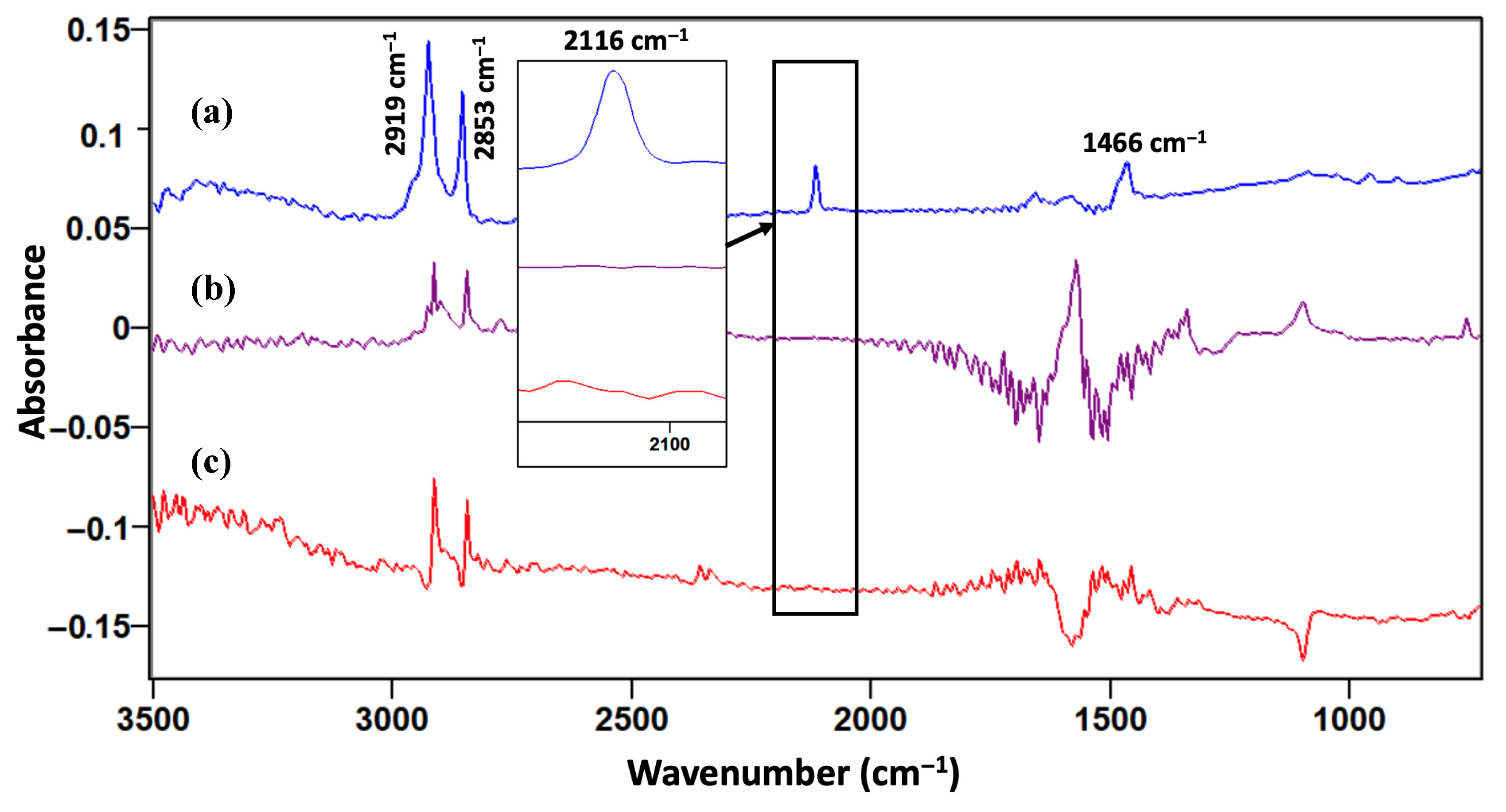
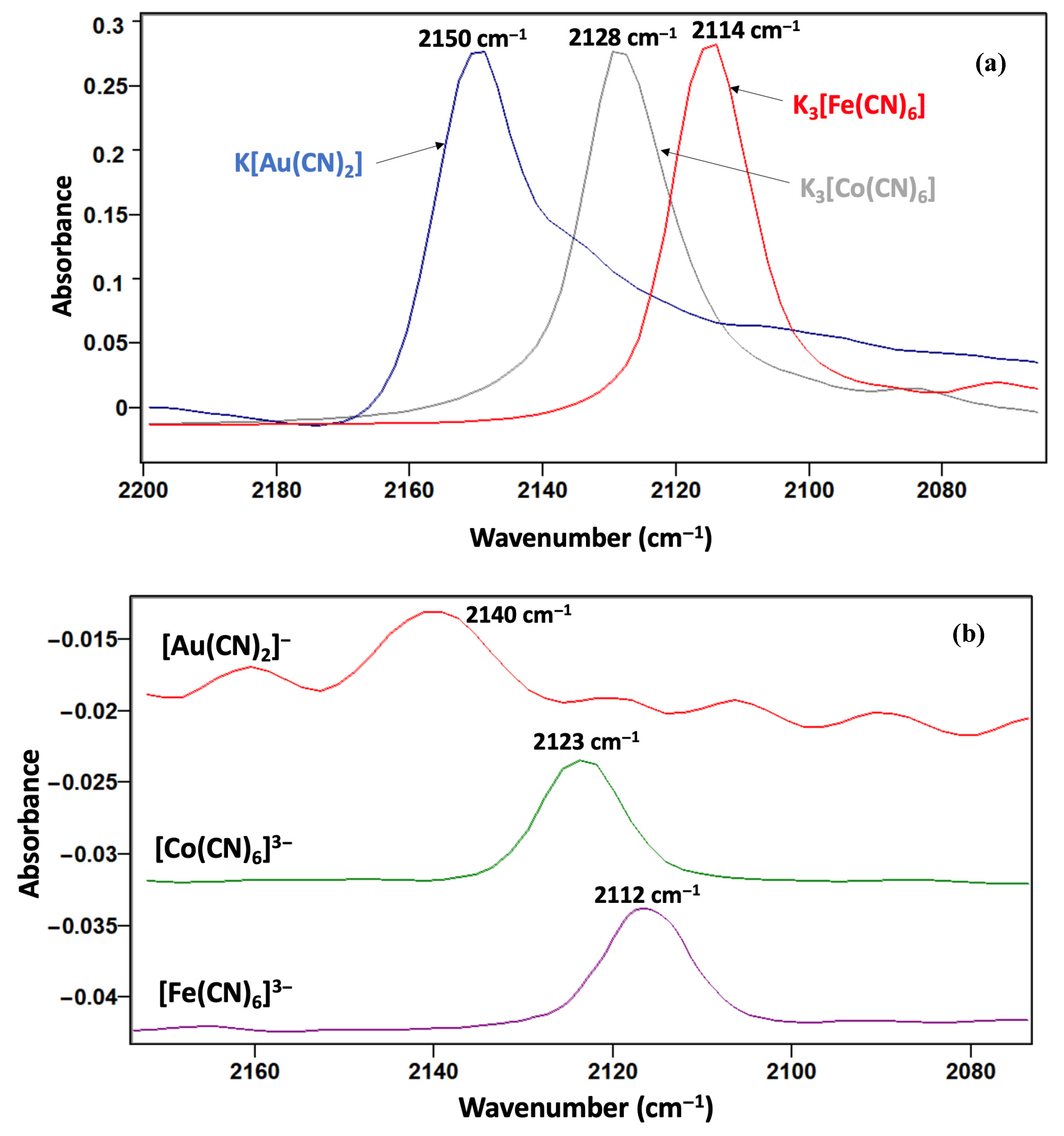

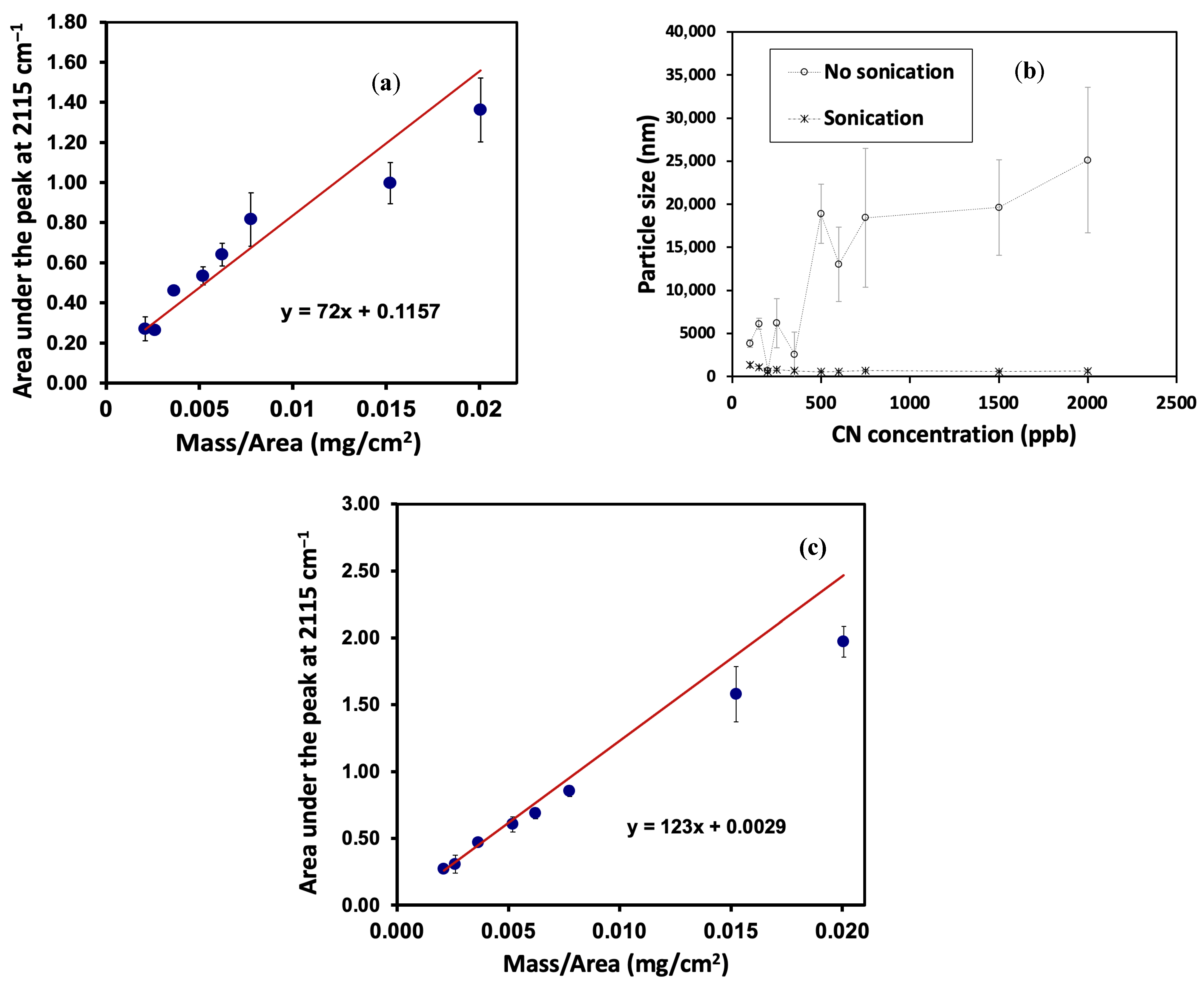
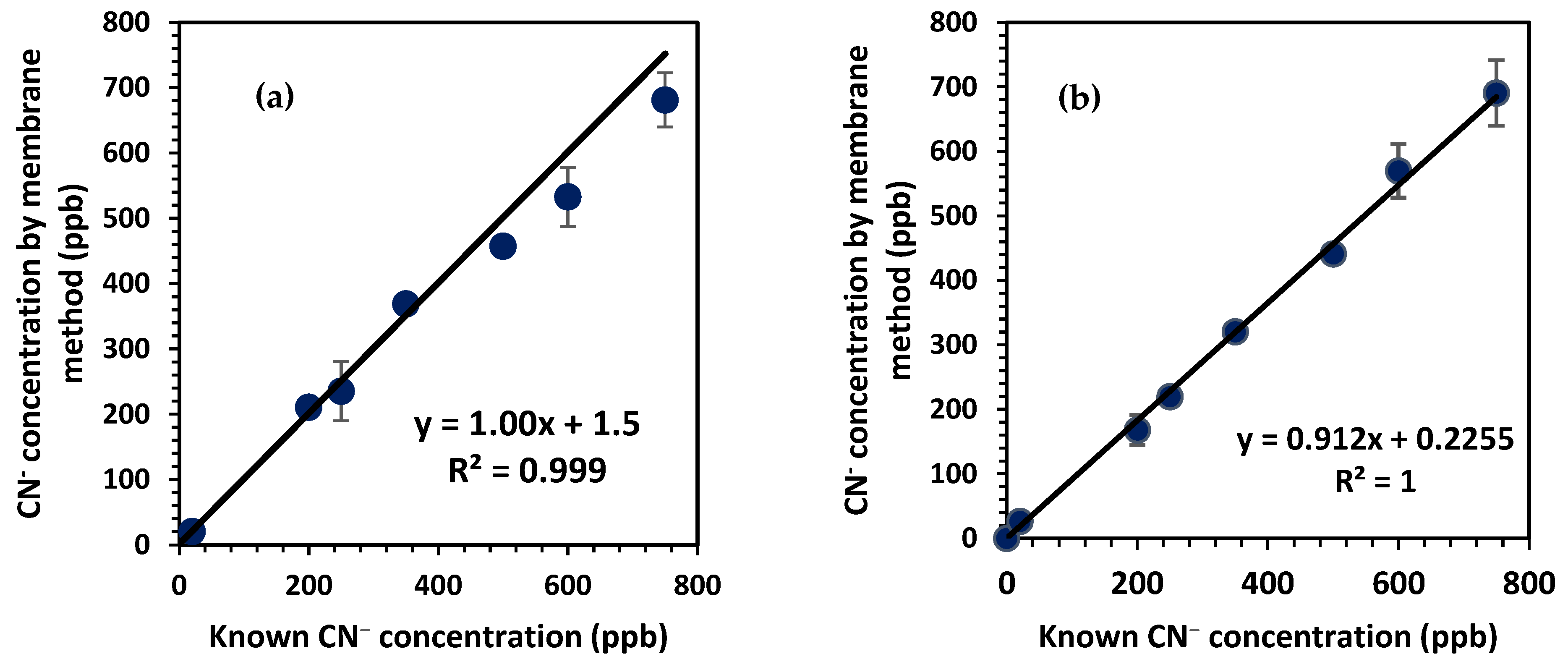

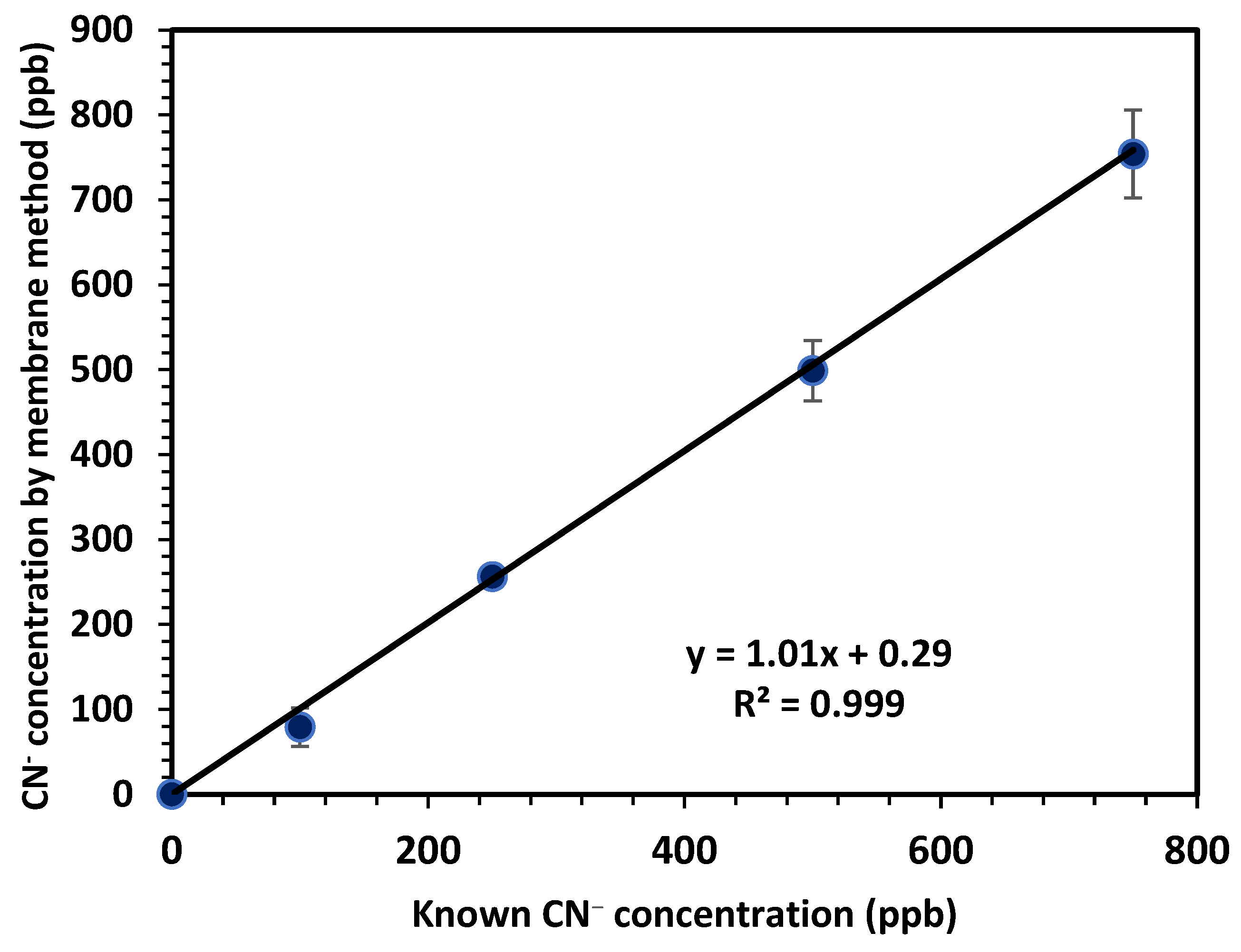


| Type of Cyanide | Method | Description |
|---|---|---|
| Free-CN | ASTM 7237 [11] | Flow injection of a cyanide sample into a solution buffered with phosphate at pH range of 6–8; the generated HCN then diffuses through a gas diffusion membrane into an NaOH solution. CN− is released, and the anodic current is measured in an amperometric flowcell detector with a silver-working electrode. |
| Free-CN + WADs-CN | EPA 9016 | Sample solution is buffered at pH 6 and introduced into a microdiffusion cell. The free cyanide diffuses as HCN, which then absorbs into a sodium hydroxide solution located at the center of the microdiffusion cell. The HCN solution is treated with acidified phosphate buffer and chloramine-T to convert the HCN to cyanogen chloride. The latter is reacted with pyridine-barbituric acid, forming a complex that absorbs at 578–587 nm. |
| Free-CN | ASTM 4282 [12] | Chlorination of free-CN with chloramine-T, followed by reaction with pyridine-barbituric acid; the resulting complex is measured colorimetrically, as described in EPA 9016. |
| WADs-CN | ASTM 6888 [13] | The sample is mixed with ligand exchange reagents followed by flow injection analysis. CN− is acidified to HCN and then diffuses through a gas diffusion membrane into an NaOH solution. The captured cyanide is measured amperometrically using a flow cell detector. |
| Total-CN | ASTM 7284 [14] | Sample is distilled in sulfamic acid containing magnesium chloride as the catalyst; CN− is acidified to HCN and measured amperometrically, as described in ASTM 6888. |
| Total-CN | ASTM 7511 [15] | Sample is digested with UV radiation to release CN−, followed by addition of concentrated sulfuric acid to form HCN. The resulting HCN is measured amperometrically, as described in ASTM 6888. |
| Total-CN | EPA 335.4 [16] | SADs-CN are converted to HCN gas by adding 18N sulfuric acid to the sample, followed by boiling and refluxing. The HCN is then collected in a scrubber containing sodium hydroxide solution. The HCN is then converted to cyanogen chloride by reacting it with chloramine-T, which subsequently reacts with pyridine and barbituric acid to give a red-colored complex. The complex is then measured colorimetrically at 570 nm. |
| Free-CN | APHA 4500-CN− method D [17] | Titration of free CN− against known amount of Ag+; the excess Ag+ reacts with p-dimethylaminobenzylidene rhodamine, forming a complex that absorbs at 490 nm. |
| [Fe(CN)6]3− Spiked | %Recovery of [Au(CN)2]− | % (±SD) (n = 3) | %Recovery of [Fe(CN)6]3− | % (±SD) (n = 3) |
|---|---|---|---|---|
| 0 | 12% | - | ||
| 2.0 | 84% | 1.5 | 98% | 1.7 |
| 2.5 | 82% | 8.5 | 97% | 10.5 |
| 3.0 | 95% | 6.8 | 93% | 2.7 |
| Cyanide Species Spiked | Recovered CN− (ppb) | %Recovery | % (±RSD) (n = 3) |
|---|---|---|---|
| Sabasticook Lake | |||
| [Fe(CN)6]3−-(60 ppb CN−) | 63 | 105 | 4 |
| [Co(CN)6]3−-(60 ppb CN−) | 65 | 108 | 4 |
| [Au(CN)2]−-(300 ppb CN−) | 244 | 81 | 5 |
| Tap water | |||
| [Fe(CN)6]3−-(60 ppb CN−) | 51 | 86 | 5 |
| [Fe(CN)6]3−-(200 ppb CN−) | 189 | 94 | 5 |
| [Co(CN)6]3−-(60 ppb CN−) | 58 | 96 | 10 |
| [Au(CN)2]−-(300 ppb CN−) | 290 | 97 | 5 |
Disclaimer/Publisher’s Note: The statements, opinions and data contained in all publications are solely those of the individual author(s) and contributor(s) and not of MDPI and/or the editor(s). MDPI and/or the editor(s) disclaim responsibility for any injury to people or property resulting from any ideas, methods, instructions or products referred to in the content. |
© 2025 by the authors. Licensee MDPI, Basel, Switzerland. This article is an open access article distributed under the terms and conditions of the Creative Commons Attribution (CC BY) license (https://creativecommons.org/licenses/by/4.0/).
Share and Cite
Masmoudi, R.; Tripp, C.P. Infrared Spectroscopic Determination of Strongly Bound Cyanides in Water. Spectrosc. J. 2025, 3, 21. https://doi.org/10.3390/spectroscj3030021
Masmoudi R, Tripp CP. Infrared Spectroscopic Determination of Strongly Bound Cyanides in Water. Spectroscopy Journal. 2025; 3(3):21. https://doi.org/10.3390/spectroscj3030021
Chicago/Turabian StyleMasmoudi, Rihab, and Carl P. Tripp. 2025. "Infrared Spectroscopic Determination of Strongly Bound Cyanides in Water" Spectroscopy Journal 3, no. 3: 21. https://doi.org/10.3390/spectroscj3030021
APA StyleMasmoudi, R., & Tripp, C. P. (2025). Infrared Spectroscopic Determination of Strongly Bound Cyanides in Water. Spectroscopy Journal, 3(3), 21. https://doi.org/10.3390/spectroscj3030021






